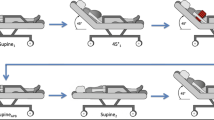Abstract
Objective
Intravesical bladder pressure (IVP) measurement is considered to be the gold standard for the assessment of intra-abdominal pressure (IAP). However, this method is indirect, discontinuous, and potentially infectious and relies on a physiological bladder function. This study evaluated two novel methods for direct, continuous IAP measurement.
Design and setting
Experimental study in an animal research laboratory.
Subjects
18 male domestic pigs.
Interventions
CO2 was insufflated to increase the IAP to 30 mmHg for 18 and 24 h in six animals each. Another six animals served as controls. A piezoresistive (PRM) and an air-capsule (ACM) pressure measurement probe were placed intra-abdominally and of IAP was measured every 1 h (PRM/ACM) or every 2 h (IVP). The mean difference between insufflator readings and IAP values and limits of agreement (mean difference ±2 SD) were calculated.
Measurements and results
In the presence of applied pressure IVP and PRM remained significantly below insufflator readings while ACM values showed no difference. Mean difference (and limits of agreement) were 4.5 (−2.1 to 11.1 mmHg), 1.6 (−8.0 to 11.2 mmHg), and 0.5 (−4.5 to 5.4 mmHg) for IVP, PRM, and ACM. The mean measurement-to-measurement drift of the ACM values was 9.0±10.2 mmHg.
Conclusions
In this model agreement of PRM and ACM with insufflator readings was comparable to IVP. As both methods may be advantageous regarding continuous straightforward measurement of IAP, the employment in further experimental and clinical investigations is suggested.
Similar content being viewed by others
References
Ivatury RR, Diebel L, Porter JM, Simon RJ (1997) Intra-abdominal hypertension and the abdominal compartment syndrome. Surg Clin North Am 77:783–800
Sugrue M, Buist MD, Lee A, Sanchez DJ, Hillman KM (1994) Intra-abdominal pressure measurement using a modified nasogastric tube: description and validation of a new technique. Intensive Care Med 20:588–590
Lee SL, Anderson JT, Kraut EJ, Wisner DH, Wolfe BM (2002) A simplified approach to the diagnosis of elevated intra-abdominal pressure. J Trauma 52:1169–1172
Johna S, Taylor E, Brown C, Zimmerman G (1999) Abdominal compartment syndrome: does intra-cystic pressure reflect actual intra-abdominal pressure? A prospective study in surgical patients. Crit Care 3:135–138
Yau YH, Piper IR, Clutton RE, Whittle IR (2000) Experimental evaluation of the Spiegelberg intracranial pressure and intracranial compliance monitor. J Neurosurg 93:1072–1077
Willy C, Gerngross H, Sterk J (1999) Measurement of intracompartmental pressure with use of a new electronic transducer-tipped catheter system. J Bone Joint Surg Am 81:158–168
Tons C, Schachtrupp A, Hoer J, Junge K, Klosterhalfen B, Schumpelick V (2002) A porcine model of the abdominal compartment syndrome. Shock 18:316–321
Hilgendorff V, Spiegelberg A, Affeld K (1987) Druckmessung im Organismus mit dem Luftkapselkatheter. Acta Chir Austria 2
Bland JM, Altman DG (1986) Statistical methods for assessing agreement between two methods of clinical measurement. Lancet I:307–310
Sugrue M (2002) Intra-abdominal pressure: time for clinical practice guidelines? Intensive Care Med 28:389–391
Iberti TJ, Lieber CE, Benjamin E (1989) Determination of intra-abdominal pressure using a transurethral bladder catheter: clinical validation of the technique. Anesthesiology 70:47–50
Tons C, Schachtrupp A, Rau M, Mumme T, Schumpelick V (2000) [Abdominal compartment syndrome: avoidance and treatment]. Chirurg 71:918–926
Yol S, Kartal A, Tavli S, Tatkan Y (1998) Is urinary bladder pressure a sensitive indicator of intra-abdominal pressure? Endoscopy 30:778–780
Fusco MA, Martin RS, Chang MC (2001) Estimation of intra-abdominal pressure by bladder pressure measurement: validity and methodology. J Trauma 50:297–302
Gudmundsson FF, Viste A, Gislason H, Svanes K (2002) Comparison of different methods for measuring intra-abdominal pressure. Intensive Care Med 28:509–514
Acknowledgements
We are grateful to Professor Kuepper, Dr. Scherer, and T. Stopinski, Department of Animal Laboratory Research, Rhenish-Westphalian Technical University of Aachen, for their invaluable help in conducting the study.
Author information
Authors and Affiliations
Corresponding author
Additional information
This research work was supported by the Deutsche Forschungsgemeinschaft and the Medical Service of the German Armed Forces.
Rights and permissions
About this article
Cite this article
Schachtrupp, A., Tons, C., Fackeldey, V. et al. Evaluation of two novel methods for the direct and continuous measurement of the intra-abdominal pressure in a porcine model. Intensive Care Med 29, 1605–1608 (2003). https://doi.org/10.1007/s00134-003-1847-3
Received:
Accepted:
Published:
Issue Date:
DOI: https://doi.org/10.1007/s00134-003-1847-3




